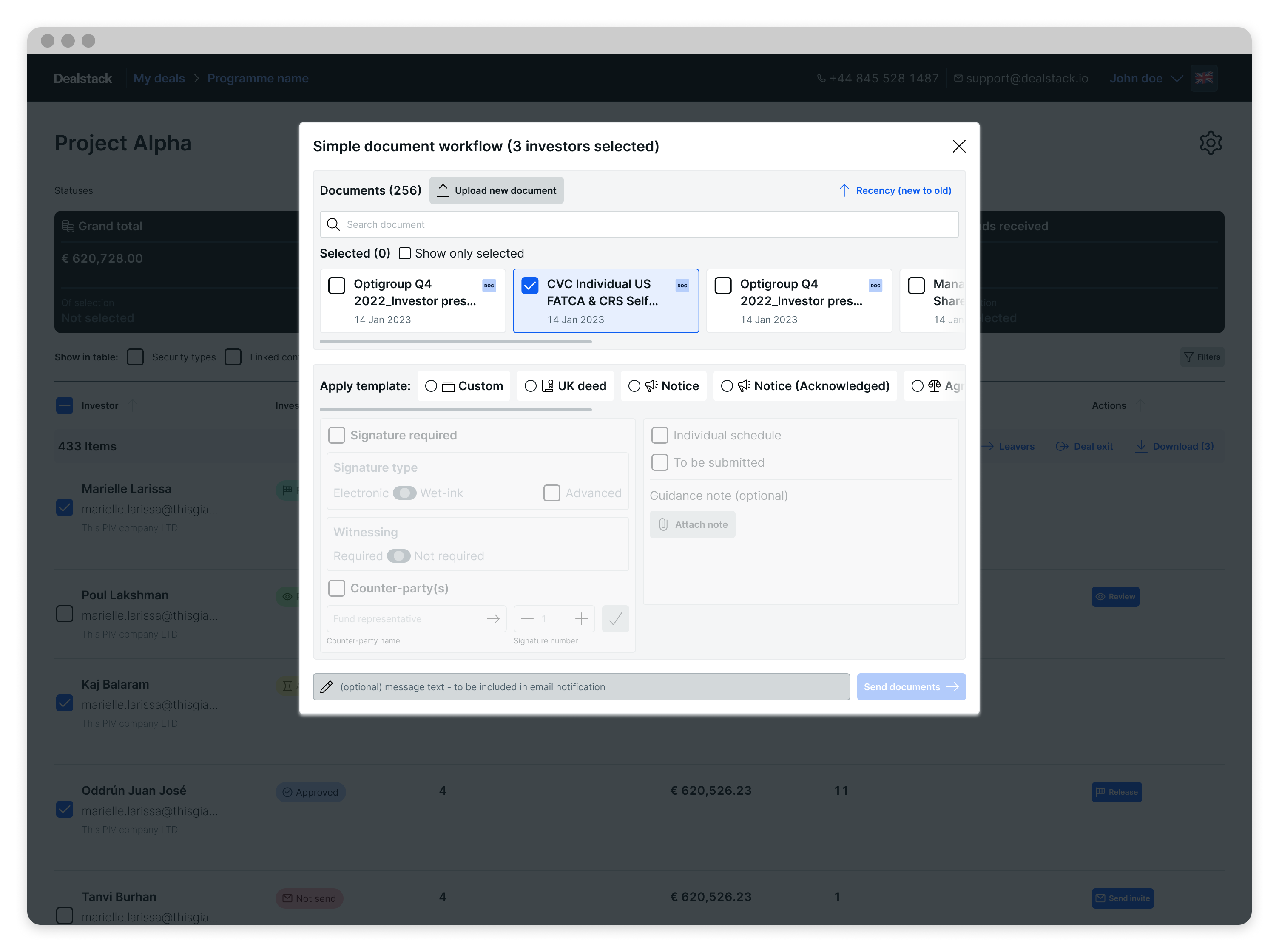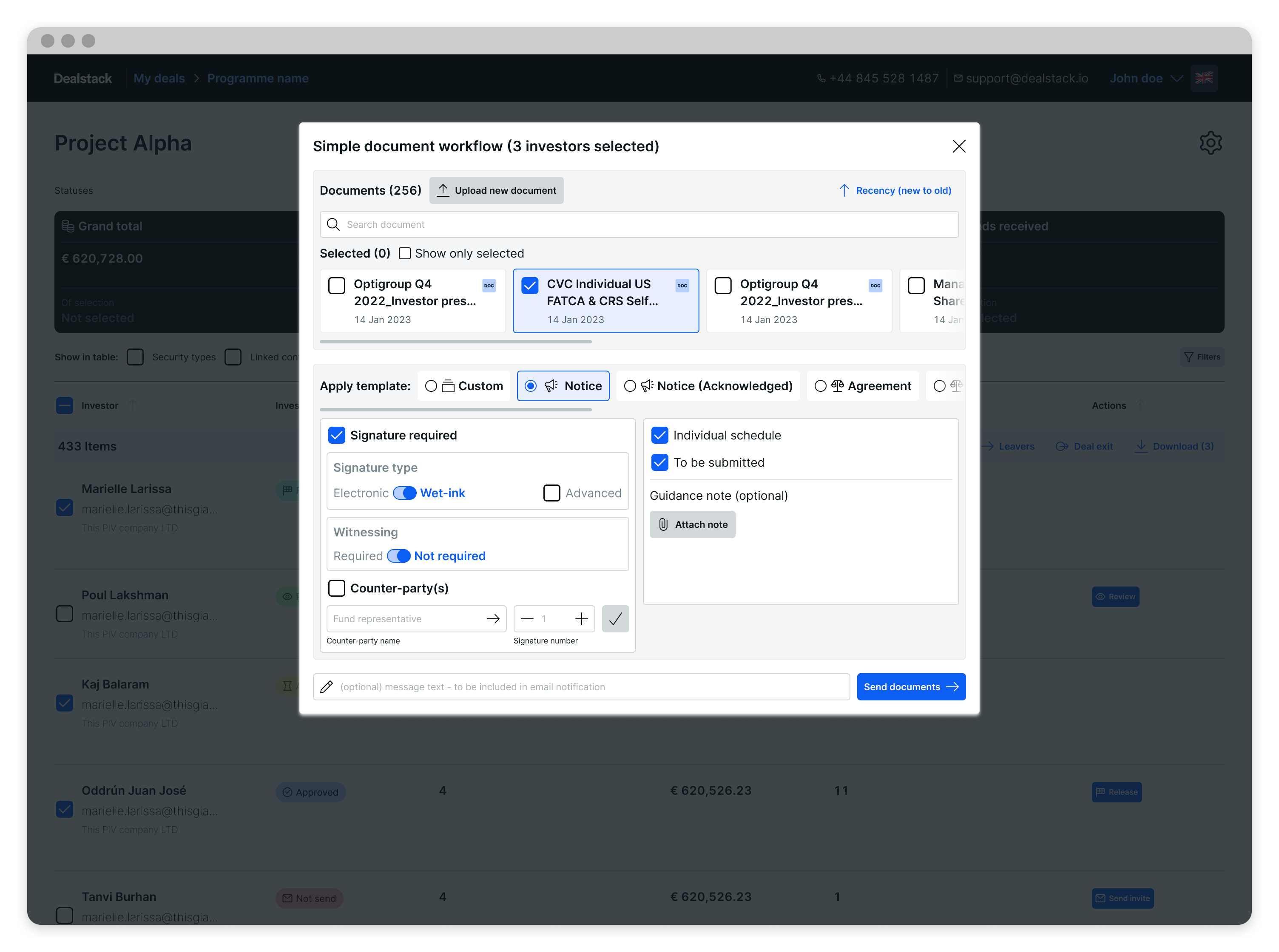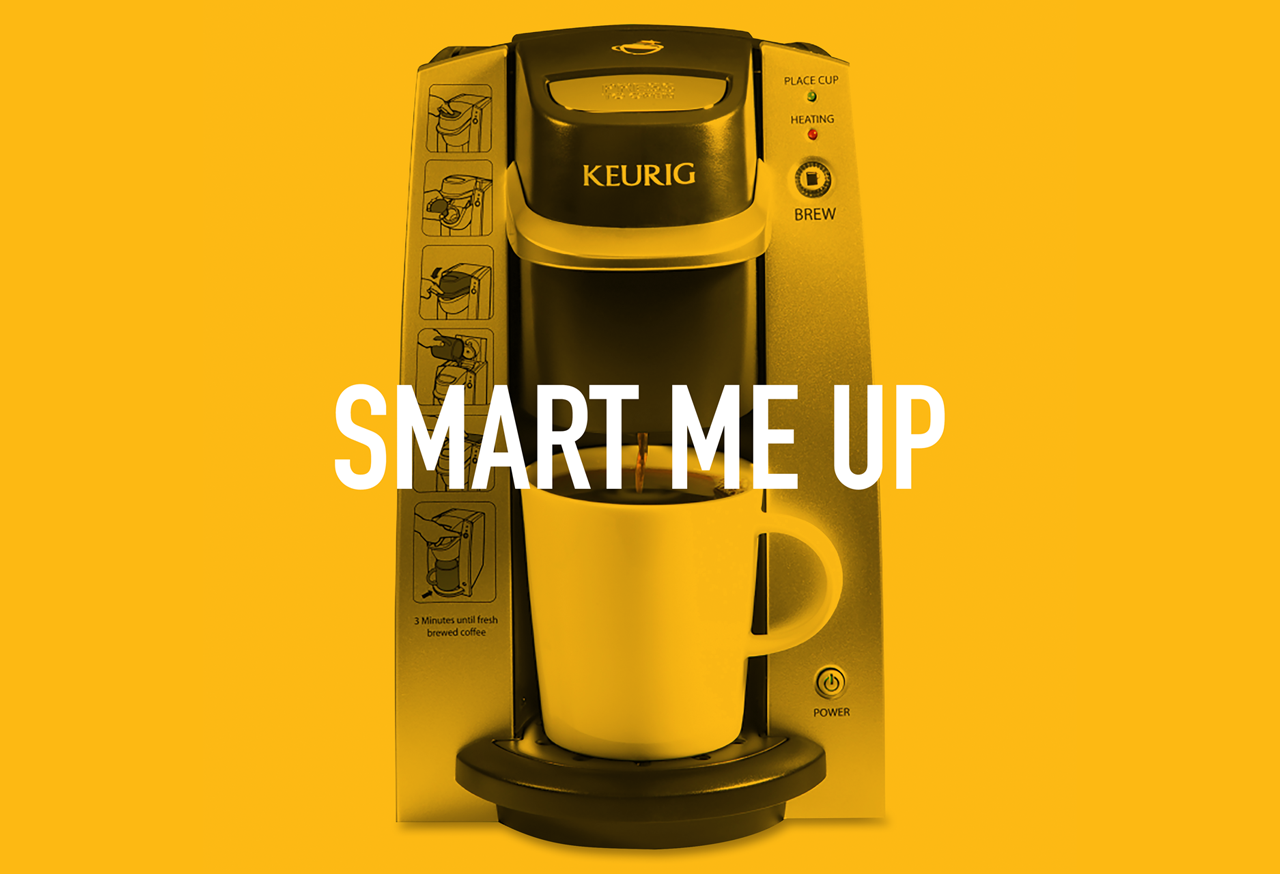Dealstack
Role: Principal Product Designer
Client: LeaderAmp
Duration: 6 months
Role: Product Designer
Client: LeaderAmp
Duration: 6 months
Role: Product Designer
₤
Document sharing workflow within IP (investment programme) module
Redesigning an enterprise leadership coaching application
Redesigning an enterprise leadership coaching application
Dealstack is a B2B SAAS product that provides a single place where private equity (PE) deals live. It enables the process of creating (entry), managing (holding) and closing (exit) a deal. This lifecycle of a deal can typically last between 3-10 years. During this period a lot of parties can be involved and there is often a lot of flux in the individual's 'capacity' that they remain involved in.
The parties involved can be lawyers, deal managers (from the PE firm) and investors (institutional and individuals investing in an investment programme) all of whom are Dealstack users. The Dealstack customer though, usually is a PE firm.
LeaderAmp is an enterprise software that aims to enhance the performance of leadership teams in large organisations. It was founded by organisational psychologist Dr Matt Barney PhD based on academic work and experience of training leaders with an Olympic-style results-driven coaching approach.
LeaderAmp is an enterprise software that aims to enhance the performance of leadership teams in large organisations. It was founded by organisational psychologist Dr Matt Barney PhD based on academic work and experience of training leaders with an Olympic-style results-driven coaching approach.
The need
Assessment
Assessment
The need for a wokflow for sending documents
The Existing App Journey
The Existing App Journey
At present, Dealstack’s investment programme module provides managing data in the investments workflow only. These are generally referred to as:
- ‘Entry’ - the initial set of investments made by management at the start of the investment programme.
- ‘Joiners’ - a further set of initial investments made by new programme members at any point following programme entry.
- ‘Additional Allocations’ - a further set of investments made by existing programme members at any point following their initial investment
- ‘Leavers’ - a sale of investments made within the investment programme. Note that ‘leavers' typically sell their entire holding, whereas ‘partial leavers’ only sell some defined proportion of their holding, and hence some holding is retained.
- ‘Exit’ - the final sale of investments made within the investment programme (at, or towards, the end of the programme). At deal exit all remaining holdings, by all investors, are sold.
There are, however, a variety of other administrative actions that are not related to any specific investment workflow which must be performed throughout the life of the investment programme. In these cases, Dealstack can provide additional value.
The app journey required selected employees of a company to first take an assessment, which told them their strengths and weaknesses (scales). Having identified their coaching needs, the app supported them to achieve and track progress. After a period of time they reassess their goals and generate a report to review progress. Users could then choose additional scales to focus on and repeat the cycle.
The app journey required selected employees of a company to first take an assessment, which told them their strengths and weaknesses (scales). Having identified their coaching needs, the app supported them to achieve and track progress. After a period of time they reassess their goals and generate a report to review progress. Users could then choose additional scales to focus on and repeat the cycle.
The users and the drivers
Assessment
Assessment
Users
The Existing App Journey
The Existing App Journey
The users of the Dealstack workflows including the 'document sharing workflow' usually is the 'deal captain' or 'deal administrator'
The app journey required selected employees of a company to first take an assessment, which told them their strengths and weaknesses (scales). Having identified their coaching needs, the app supported them to achieve and track progress. After a period of time they reassess their goals and generate a report to review progress. Users could then choose additional scales to focus on and repeat the cycle.
The app journey required selected employees of a company to first take an assessment, which told them their strengths and weaknesses (scales). Having identified their coaching needs, the app supported them to achieve and track progress. After a period of time they reassess their goals and generate a report to review progress. Users could then choose additional scales to focus on and repeat the cycle.
Drivers (User Needs)
The Existing App Journey
The Existing App Journey
Simple document workflows are characterised as:
- Being unrelated to any specific investment activity
- Able to be initiated & completed regardless of an investor’s investment status, or the status of any associated investment workflows
- Requiring the review of a document issued by a deal manager by one or more investors
- Involving some notification to investors that their action is required, with respect to the document
- Optionally requiring some completion and/or signature of that document by the investor (as required by the deal manager)
- Requiring a review and approval of any such completed/signed document by the deal manager
The app journey required selected employees of a company to first take an assessment, which told them their strengths and weaknesses (scales). Having identified their coaching needs, the app supported them to achieve and track progress. After a period of time they reassess their goals and generate a report to review progress. Users could then choose additional scales to focus on and repeat the cycle.
The app journey required selected employees of a company to first take an assessment, which told them their strengths and weaknesses (scales). Having identified their coaching needs, the app supported them to achieve and track progress. After a period of time they reassess their goals and generate a report to review progress. Users could then choose additional scales to focus on and repeat the cycle.
Business Drivers
The Existing App Journey
The Existing App Journey
There are a variety of circumstances where the deal manager needs to be able to initiate simple document workflows with a programme’s investors:
- Document review only
- Annual Report
- Company Valuation
- Notice
- Document signature
- Signature of a ‘power of attorney’ document
- Signature of a written shareholders resolution
- Response to a notice (i.e. a notice which requires an acknowledgement)
- Document completion
- An ad-hoc information request, which may be achieved by completion of a pdf form.
The app journey required selected employees of a company to first take an assessment, which told them their strengths and weaknesses (scales). Having identified their coaching needs, the app supported them to achieve and track progress. After a period of time they reassess their goals and generate a report to review progress. Users could then choose additional scales to focus on and repeat the cycle.
The app journey required selected employees of a company to first take an assessment, which told them their strengths and weaknesses (scales). Having identified their coaching needs, the app supported them to achieve and track progress. After a period of time they reassess their goals and generate a report to review progress. Users could then choose additional scales to focus on and repeat the cycle.
The workflow and the process
Assessment
Assessment
Process Overview
The Existing App Journey
The Existing App Journey
The diagram below illustrates a simple document distribution process:
The app journey required selected employees of a company to first take an assessment, which told them their strengths and weaknesses (scales). Having identified their coaching needs, the app supported them to achieve and track progress. After a period of time they reassess their goals and generate a report to review progress. Users could then choose additional scales to focus on and repeat the cycle.
The app journey required selected employees of a company to first take an assessment, which told them their strengths and weaknesses (scales). Having identified their coaching needs, the app supported them to achieve and track progress. After a period of time they reassess their goals and generate a report to review progress. Users could then choose additional scales to focus on and repeat the cycle.
The diagram below illustrates a more complex process, involving investor (electronic) signature and deal manager review of a document:
The app journey required selected employees of a company to first take an assessment, which told them their strengths and weaknesses (scales). Having identified their coaching needs, the app supported them to achieve and track progress. After a period of time they reassess their goals and generate a report to review progress. Users could then choose additional scales to focus on and repeat the cycle.
The app journey required selected employees of a company to first take an assessment, which told them their strengths and weaknesses (scales). Having identified their coaching needs, the app supported them to achieve and track progress. After a period of time they reassess their goals and generate a report to review progress. Users could then choose additional scales to focus on and repeat the cycle.
Solution prototypes
Assessment
Assessment
A note on missing 'wireframes'
The Existing App Journey
The Existing App Journey
At Dealstack, I've worked a great deal on making our design system robust and rich enough that we often go from paper to prototypes (that almost look like finished designs) without going through the grey wireframy phase.
Why? Because it is more efficient. We waste less time designing things twice and we get to delivering and iterating on solutions faster because what we work on allows you to visualise the actual solution from the get-go.
The app journey required selected employees of a company to first take an assessment, which told them their strengths and weaknesses (scales). Having identified their coaching needs, the app supported them to achieve and track progress. After a period of time they reassess their goals and generate a report to review progress. Users could then choose additional scales to focus on and repeat the cycle.
The app journey required selected employees of a company to first take an assessment, which told them their strengths and weaknesses (scales). Having identified their coaching needs, the app supported them to achieve and track progress. After a period of time they reassess their goals and generate a report to review progress. Users could then choose additional scales to focus on and repeat the cycle.
Prototype #1
The Existing App Journey
The Existing App Journey
Sending documents and appending the requirements using a (easily overwritable) curated list nestled within a dropdown
The app journey required selected employees of a company to first take an assessment, which told them their strengths and weaknesses (scales). Having identified their coaching needs, the app supported them to achieve and track progress. After a period of time they reassess their goals and generate a report to review progress. Users could then choose additional scales to focus on and repeat the cycle.
The app journey required selected employees of a company to first take an assessment, which told them their strengths and weaknesses (scales). Having identified their coaching needs, the app supported them to achieve and track progress. After a period of time they reassess their goals and generate a report to review progress. Users could then choose additional scales to focus on and repeat the cycle.
Prototype #2
The Existing App Journey
The Existing App Journey
Sending documents and appending the requirements using a (easily overwritable) curated list without a dropdown
The app journey required selected employees of a company to first take an assessment, which told them their strengths and weaknesses (scales). Having identified their coaching needs, the app supported them to achieve and track progress. After a period of time they reassess their goals and generate a report to review progress. Users could then choose additional scales to focus on and repeat the cycle.
The app journey required selected employees of a company to first take an assessment, which told them their strengths and weaknesses (scales). Having identified their coaching needs, the app supported them to achieve and track progress. After a period of time they reassess their goals and generate a report to review progress. Users could then choose additional scales to focus on and repeat the cycle.
What did we learn?
Assessment
Assessment
Dropdowns didn't work
The Existing App Journey
The Existing App Journey
While the dropdown allowed to keep things focussed on sending documents one at a time (while applying its configurations), we learned that users sometimes wanted to apply configurations for many documents all at the same time and at other times just send a single document. So we needed to cater to both scenarios.
The app journey required selected employees of a company to first take an assessment, which told them their strengths and weaknesses (scales). Having identified their coaching needs, the app supported them to achieve and track progress. After a period of time they reassess their goals and generate a report to review progress. Users could then choose additional scales to focus on and repeat the cycle.
The app journey required selected employees of a company to first take an assessment, which told them their strengths and weaknesses (scales). Having identified their coaching needs, the app supported them to achieve and track progress. After a period of time they reassess their goals and generate a report to review progress. Users could then choose additional scales to focus on and repeat the cycle.
Multiple and single document sending were both important
The Existing App Journey
The Existing App Journey
The final designs incorporated a method in which the configurations could be applied to multiple documents upon selection while activating it also allowed to make further specific changes only to the activated documents
The app journey required selected employees of a company to first take an assessment, which told them their strengths and weaknesses (scales). Having identified their coaching needs, the app supported them to achieve and track progress. After a period of time they reassess their goals and generate a report to review progress. Users could then choose additional scales to focus on and repeat the cycle.
The app journey required selected employees of a company to first take an assessment, which told them their strengths and weaknesses (scales). Having identified their coaching needs, the app supported them to achieve and track progress. After a period of time they reassess their goals and generate a report to review progress. Users could then choose additional scales to focus on and repeat the cycle.
Hi-fi screens of the implemented solution
Assessment
Assessment
Actual demo
Assessment
Assessment
Below is a screen recording of the document sending workflow's actual product demo
The app journey required selected employees of a company to first take an assessment, which told them their strengths and weaknesses (scales). Having identified their coaching needs, the app supported them to achieve and track progress. After a period of time they reassess their goals and generate a report to review progress. Users could then choose additional scales to focus on and repeat the cycle.
The app journey required selected employees of a company to first take an assessment, which told them their strengths and weaknesses (scales). Having identified their coaching needs, the app supported them to achieve and track progress. After a period of time they reassess their goals and generate a report to review progress. Users could then choose additional scales to focus on and repeat the cycle.
Outcome
Assessment
Assessment
Sending documents using the 'simple document workflow has enabled Dealstack users to quickly be able to send documents while attaching configurations after a laborious process of setting up deals and investment workflows.
The way it was designed and implemented also allows for the flexibility of sending a document quickly as well as making it into a separate rich workflow in itself as well.
The app journey required selected employees of a company to first take an assessment, which told them their strengths and weaknesses (scales). Having identified their coaching needs, the app supported them to achieve and track progress. After a period of time they reassess their goals and generate a report to review progress. Users could then choose additional scales to focus on and repeat the cycle.
The app journey required selected employees of a company to first take an assessment, which told them their strengths and weaknesses (scales). Having identified their coaching needs, the app supported them to achieve and track progress. After a period of time they reassess their goals and generate a report to review progress. Users could then choose additional scales to focus on and repeat the cycle.
Footnote: The CAP table project was designed and implemented over 3 weeks in September 2023. The phases included lots of testing, demos and revisions. Since then, it has been absorbed into the product catalogue with feature improvements and bug fixes added in based on product planning
Footnote: LeaderAmp was designed in August 2016 and development work happened in parallel. The app went live in the Android Play Store and the Apple App Store. Some content has since been modified including LeaderAmp’s logo.
Footnote: LeaderAmp was designed in August 2016 and development work happened in parallel. The app went live in the Android Play Store and the Apple App Store. Some content has since been modified including LeaderAmp’s logo.
Other Projects

CAP table @ DealstackProduct Design
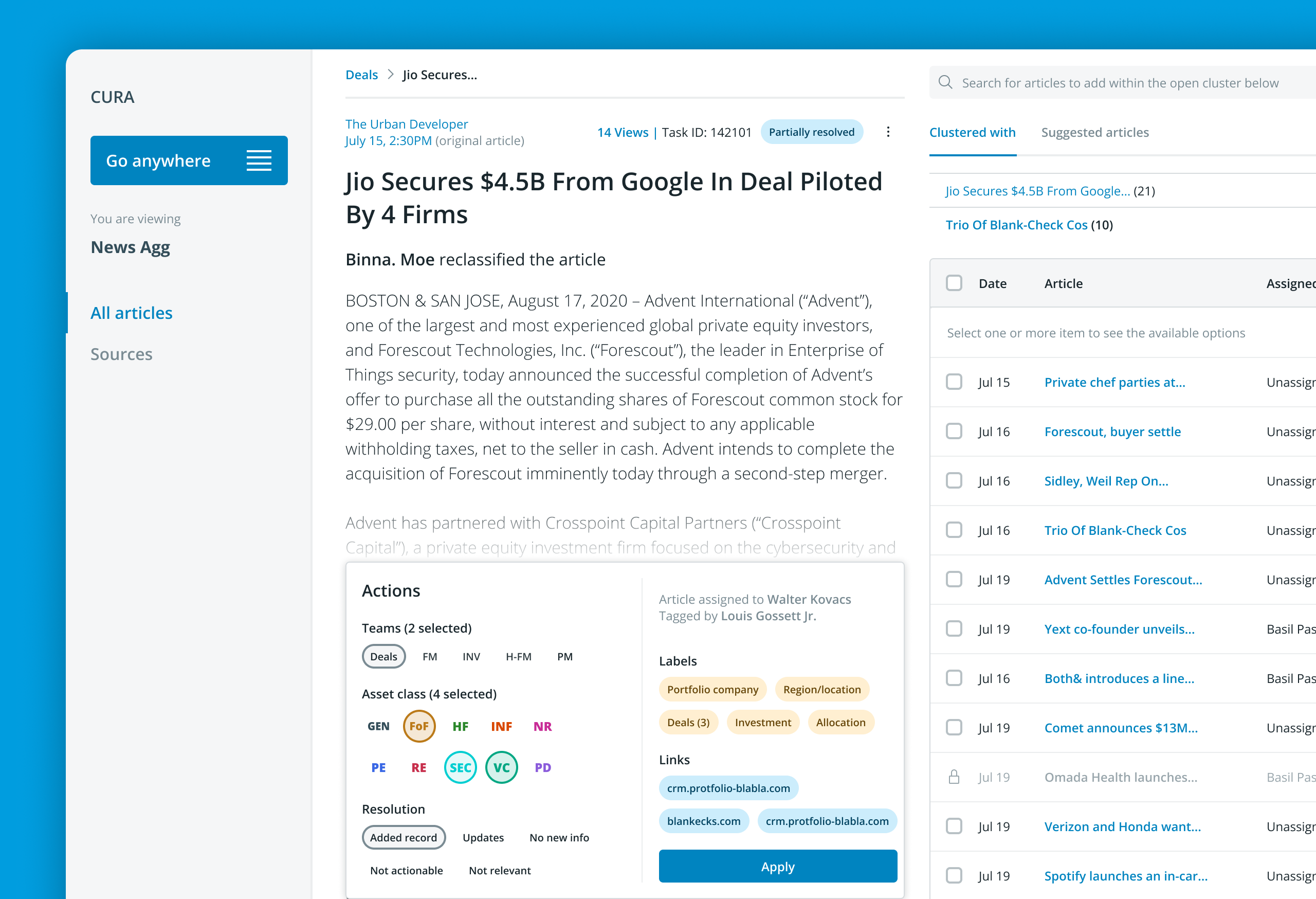
Redesigning a news aggregator tool @ PreqinProduct design
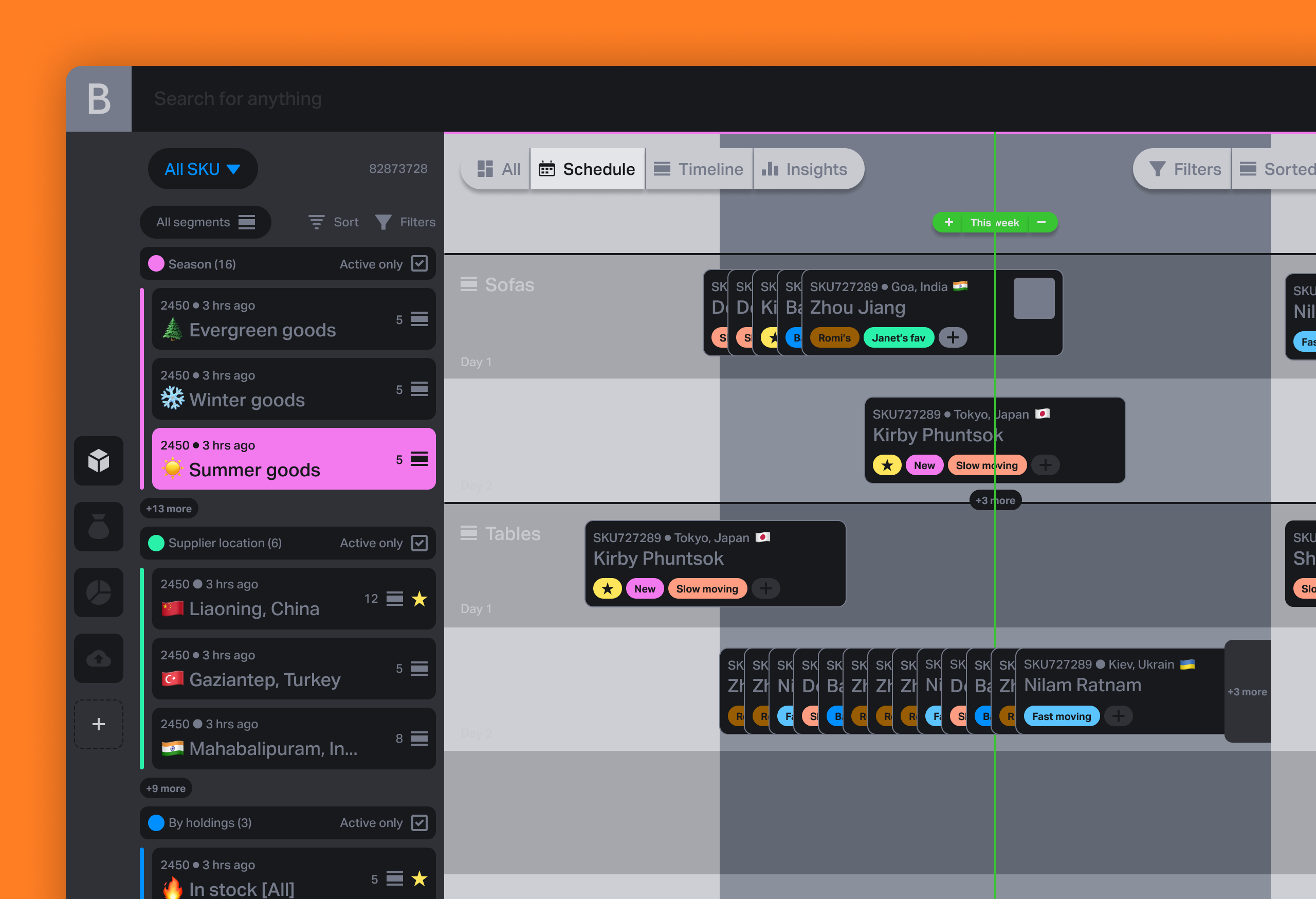
Various design works and thought leadership @ BeaconProduct Design & leadership

Tap Tap SignupUI + UX

Design systems design @ PreqinProduct Design

Repositioning by rebranding: the Moonraft brand storyProduct Design

SurePeople Proper HamburgerUI + UX

2018 CalendarGraphic Design

Rejected Web DesignsWeb Design
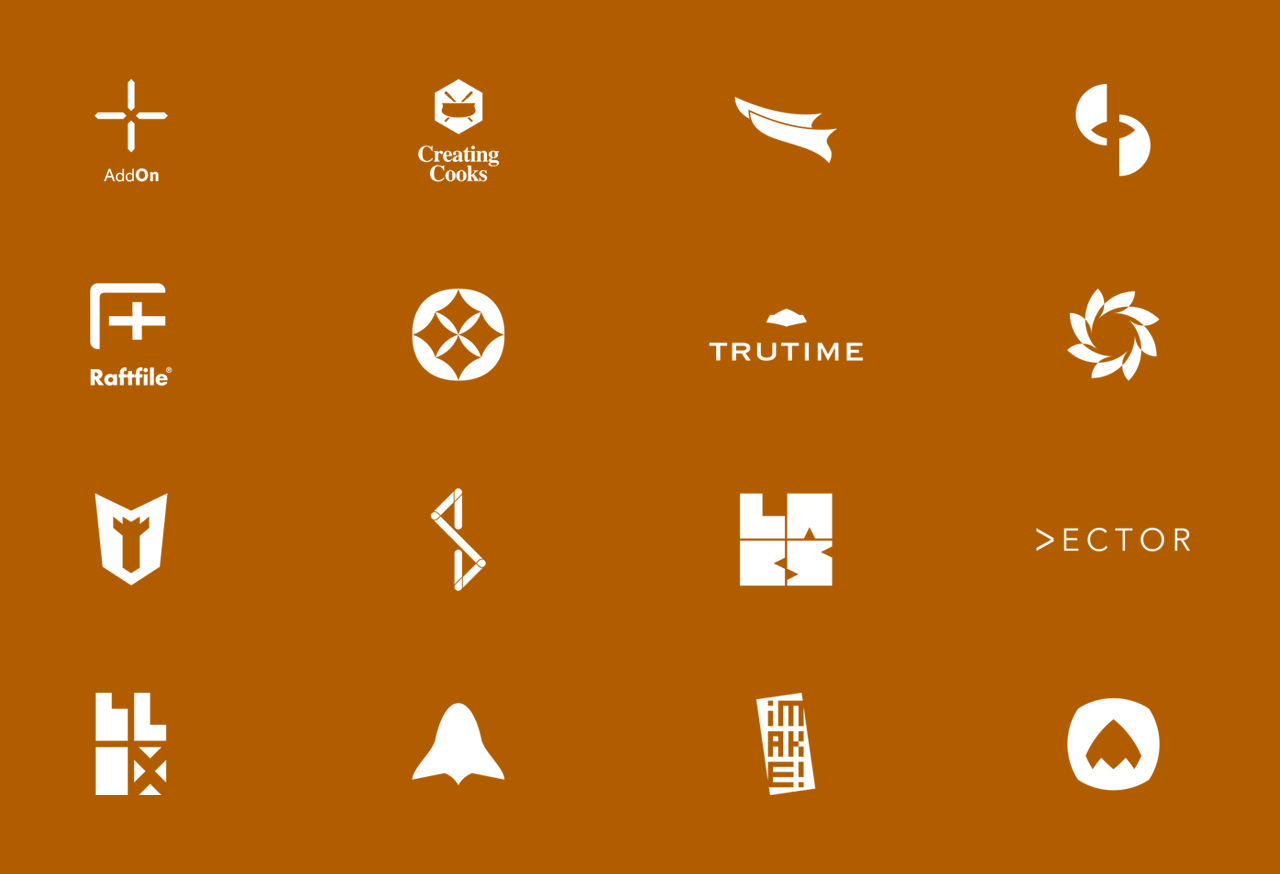
LogofolioGraphic Design
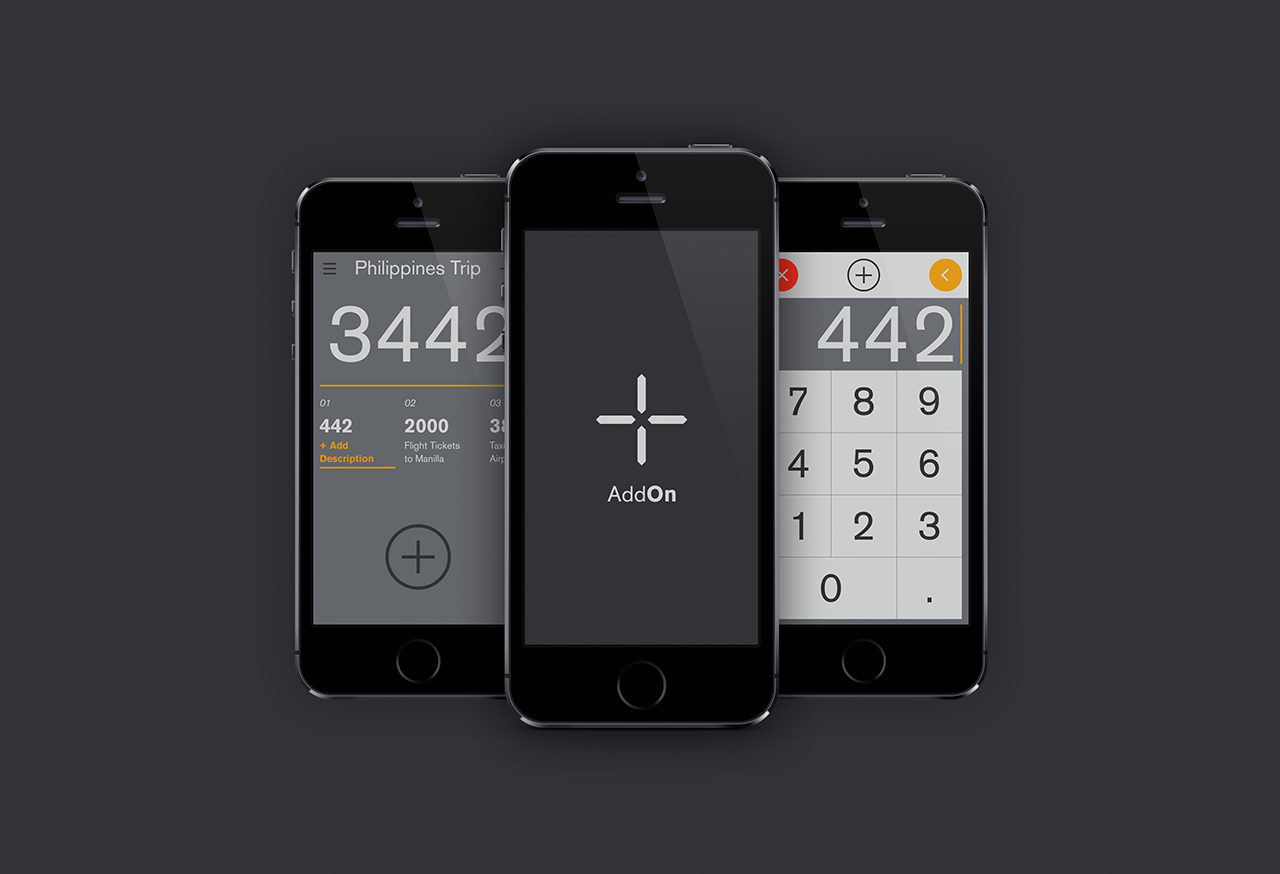
AddOn for numbersUI / UX
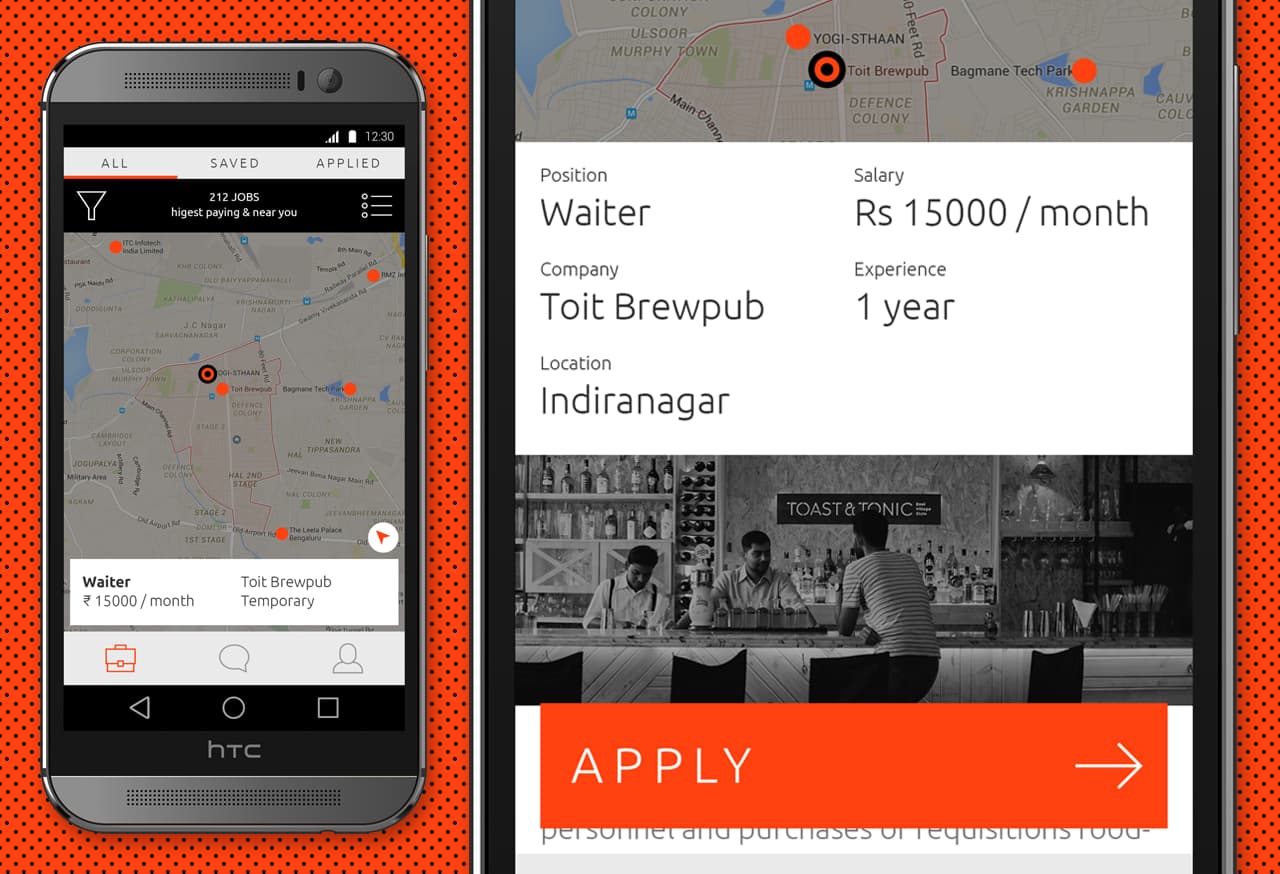
Designing an app for the grey collared job marketProduct Design

Pankaj & Priya wedding collateral designsGraphic Design

The MYLK propaganda designsGraphic Design

LogofolioGraphic Design






